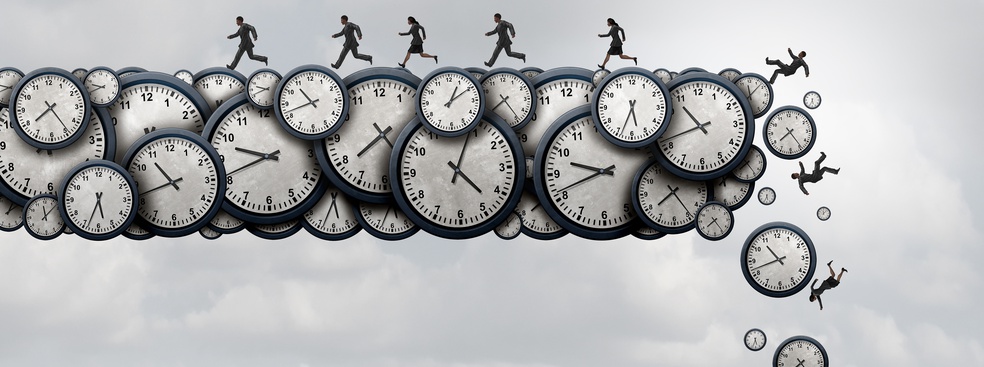With ESSEC Knowledge Editor-in-chief
I get a buzz out of working hard. In fact, when I don’t have deadlines, I get bored. I’m much less productive because I like working on adrenaline. [...] I get a buzz out of it, that’s why I do the job that I do. I like it (Eric, director).
2022 is in full swing, and our work calendars are starting to fill up again after a welcome holiday break. Despite enjoying this downtime, many of us are packing our calendars full of meetings and projects, even if this means more work. Why do we do this to ourselves- what makes us want to keep busy, even if it takes a toll on our wellbeing? Ioana Lupu (ESSEC Business School) and Joonas Rokka (EMLYON Business School) found that how people experience time control at work (overused - balanced - underused) impacts their perceptions of busyness. In order to explain professionals’ attraction toward busyness (for an illustration, see the opening quote), the researchers propose the concept of “optimal busyness”, a specific kind of attractive and energizing temporal experience that professionals search for because it makes them feel energized and productive as well as in control of their time. This study shows that employees’ experience of optimal busyness gets them seduced into believing that they can control the temporal demands of their work and so they inevitably end up working more than they should.
Organizational control of time
Managers trying to motivate their employees is nothing new, and neither is their use of strategies to keep people in line with the company’s goals. These strategies aim to manage their performance and their adherence to temporal norms like long working hours and strict time management. Examples include performance evaluations, coworker actions, and productivity technology. These impact how employees manage their time, and can encourage a poor work-life balance. They can also be hard to resist, so employees end up conforming. On top of that, they can shape how people experience their work time, making them feel temporarily invigorated and leading them to chase that feeling. The researchers set out to explore how exactly professionals experience their work time, as a result of the action of organizational controls, a previously unexplored aspect of the literature.
A study of busyness
Lupu and Rokka’s interviews with professionals were particularly focused on how people went about their daily activities and how they structured how much time they spent on those activities. To explore employees’ relationship to busyness, they compiled a dataset consisting of 146 interviews with 81 professionals, over 300 weekly diaries, fieldwork observations, and archival data like internal HR documents. The combination of these four data sources formed a thorough dataset of both the professionals’ experiences and the firms’ practices.
Participants were employees at a global auditing firm and a law firm based in London: fast-paced settings where long hours, intense work, and billable hours are the norm. They spoke about the highs and lows of their careers and personal lives, explaining how they coped with the numerous deadlines and the fast-paced work-rhythm, how they felt during busy vs. quiet periods, and about the different factors impacting their stress levels.
Busyness as a result of organizational controls
Busyness was a recurring theme in the interviews. The researchers also noticed a perplexing pattern: even when people felt their work-life balance was off, they still preferred busy periods over quiet ones. From this, they identified three key temporal experiences: quiet time, optimal busyness, and excessive busyness. Organizational conditions shape these experiences.
To understand how exactly organizational conditions linked to professionals’ temporal experiences, they explored the “temporality of controls”: the structuring, rarefying, and synchronization of time. Structuring time refers to how professionals’ time is organized: here, they looked at deadlines and time sheets. These shape how people allocate and account for their time - and even justify their worth, since if they meet deadlines and bill more hours, they’re seen more positively and as more valuable. Time sheets also encourage people to minimize the time they spend on non-billable hours, such as training.
Rarefying time makes time feel scarce and fosters a feeling of urgency. They focused on this construction of urgency and short-term deadlines, and on “temporal intensification”, meaning people work faster and faster to squeeze in more work. These contribute to a focus on the here and now, rather than a feeling of long-term value creation and planning.
Synchronization of time, the third way that temporality of controls plays out, that is aligning organizational and individual time experiences, manifests through attuning and time collectivization. Attuning means getting employees on board with the work rhythm: for example, providing laptops and phones to make sure people are constantly connected. Time collectivization means creating a shared experience, like sacrificing one’s time to achieve a common goal. By creating this shared higher purpose, team members bond and a time management norm is born.
The use of these controls influences employees’ perceptions of their activities, resulting in the aforementioned periods of quiet time, optimal busyness, and excessive busyness. The key here is that employees’ experiences will differ based on their own perceptions of the controls. When they feel like this control is overused, it leads to excessive busyness (high levels of the three controls), and individuals feel fatigued, less productive, and note higher work-life conflict levels. When they think that control is underused (weak levels), they experience a period of quiet time, and feel less productive, bored, and anxious, though with less work-life conflict. And like Goldilocks, when they see control as balanced (moderate levels of all three), their temporal experience is “just right” and they experience optimal busyness. People tend to oscillate between the three states and the accompanying emotions. Participants also noted that the periods of busyness were best when they were short and that there was an end in sight- and long quiet periods also made people feel anxious and bored. This suggests that organizational controls still had an impact even when they seemed less present, such as in quiet periods.
Professionals also try to shape their own temporal experience to achieve this state of optimal busyness, since it feels energizing and productive and they feel in control - but this is a flawed approach and can lead to overwork in the attempt to hit the sweet spot. They do so by a process called control of temporality, which involves changing their pace, the target of their focus, and the length they see the busyness being. By pushing themselves to work at a faster pace (including using coffee or other substances), focusing on the short-term, and telling themselves the busyness will be short-term, they try to continuously recreate the optimal busyness state.
What can we learn from optimal busyness?
How do organizational factors impact how professionals view their time when busy, and how do they react to their experiences? The researchers found that organizational controls influence employees’ temporal experiences by structuring, rarefying and synchronizing time. When employees experience a balanced level of all three, they experience an optimal busyness state. This indicates that they feel adequate organizational pressure to perform and that this pressure is not overwhelming and at the same time they still feel in control of their time.
Professionals also tend to replicate this themselves by modifying their own behaviors.
While this optimal busyness can lead to positive feelings and productivity in the short-term, over time it can lead to overwork and decrease of productivity and motivation as well as work-life conflict. While optimal busyness is fleeting, employees will continue to chase it through their use of time.
These findings shed light on the relationship between organizational control and time, and on why people are drawn to long hours and comply with demanding time pressures: it’s in the pursuit of optimal busyness. Similarly to the employees interviewed, many people nowadays look for excitement, buzz and adrenaline in their work, epitomized in the search for optimal busyness, but because work does not have an end, this often ends up making them overwork.
Reference
Lupu, I., & Rokka, J. (2021). “Feeling in Control”: Optimal Busyness and the Temporality of Organizational Controls. Organization Science.









